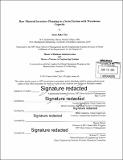| dc.contributor.advisor | Donald Rosenfield and Bruce Cameron. | en_US |
| dc.contributor.author | Choi, Jason Jinho | en_US |
| dc.contributor.other | Leaders for Global Operations Program. | en_US |
| dc.date.accessioned | 2014-10-08T15:28:22Z | |
| dc.date.available | 2014-10-08T15:28:22Z | |
| dc.date.copyright | 2014 | en_US |
| dc.date.issued | 2014 | en_US |
| dc.identifier.uri | http://hdl.handle.net/1721.1/90775 | |
| dc.description | Thesis: M.B.A., Massachusetts Institute of Technology, Sloan School of Management, 2014. In conjunction with the Leaders for Global Operations Program at MIT. | en_US |
| dc.description | Thesis: S.M., Massachusetts Institute of Technology, Engineering Systems Division, 2014. In conjunction with the Leaders for Global Operations Program at MIT. | en_US |
| dc.description | Cataloged from PDF version of thesis. | en_US |
| dc.description | Includes bibliographical references (pages 53-54). | en_US |
| dc.description.abstract | The thesis explores inventory management principles in the context of a storage capacity constrained warehouse. Amgen Inc. is building a new manufacturing facility in Singapore. Due to internal raw material warehouse capacity constraints, Amgen is evaluating the use of a 3rd Party Logistics (3PL) for additional warehousing space. The goal of this project is to recommend a raw material inventory strategy to reduce inventory levels and a 3PL operation guideline to ensure the availability of storage space and to minimize the transfers of raw material between Amgen and the 3PL. The project developed four inventory management methodologies to reduce raw material inventory in the context of a warehouse with a capacity constraint: I. Batch size optimization with an extension of the economic order quantity (EOQ) that adjusts batch size based on available warehouse space. 2. Safety stock reduction with the removal of demand variability by fixing the production schedule for 6 months. This results in a 10% inventory reduction by value and an 18% reduction in warehouse space usage. 3. Vendor managed inventory (VMI) with suppliers in Singapore to reduce inventory by 5%. 4. Maintaining commonality of disposable raw materials at 75% for new products that use the Manufacturing of the Future (MoF) platform to mitigate a 46% increase in room temperature warehouse space. As Amgen starts to use a 3PL, we recommend: 1. Use the 3PL in series with Amgen's warehouse to minimize raw material transfers. 2. Use the created warehouse model for 3PL operation guidelines. The model calculates the raw material requirements for a given production plan and recommends how to route the raw material and computes the space required for Amgen and the 3PL. 3. Use recommended key performance indicators to ensure data input into the warehouse model is accurate for correctly optimized results. | en_US |
| dc.description.statementofresponsibility | by Jason Jinho Choi. | en_US |
| dc.format.extent | 54 pages | en_US |
| dc.language.iso | eng | en_US |
| dc.publisher | Massachusetts Institute of Technology | en_US |
| dc.rights | M.I.T. theses are protected by copyright. They may be viewed from this source for any purpose, but reproduction or distribution in any format is prohibited without written permission. See provided URL for inquiries about permission. | en_US |
| dc.rights.uri | http://dspace.mit.edu/handle/1721.1/7582 | en_US |
| dc.subject | Sloan School of Management. | en_US |
| dc.subject | Engineering Systems Division. | en_US |
| dc.subject | Leaders for Global Operations Program. | en_US |
| dc.title | Raw material inventory planning in a serial system with warehouse capacity | en_US |
| dc.type | Thesis | en_US |
| dc.description.degree | M.B.A. | en_US |
| dc.description.degree | S.M. | en_US |
| dc.contributor.department | Leaders for Global Operations Program at MIT | en_US |
| dc.contributor.department | Massachusetts Institute of Technology. Engineering Systems Division | |
| dc.contributor.department | Sloan School of Management | |
| dc.identifier.oclc | 891565747 | en_US |
